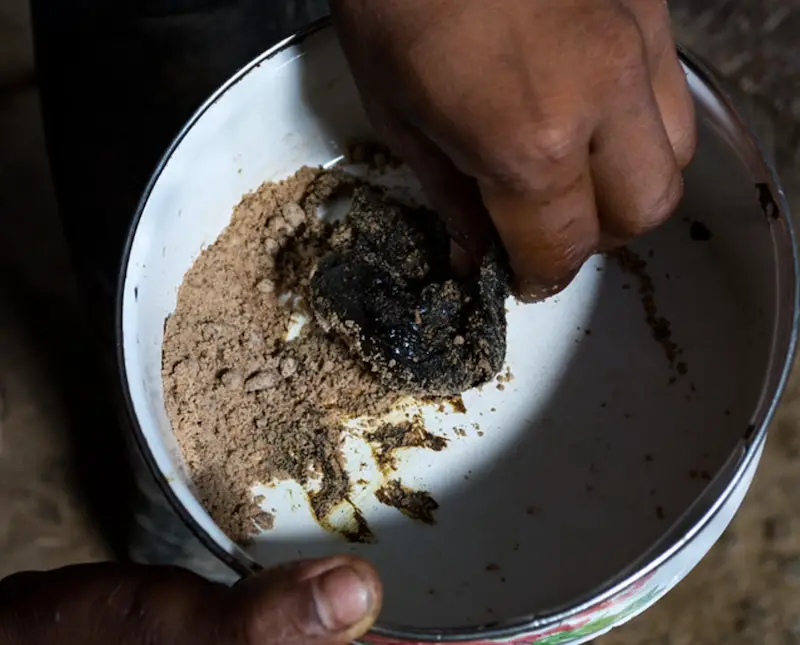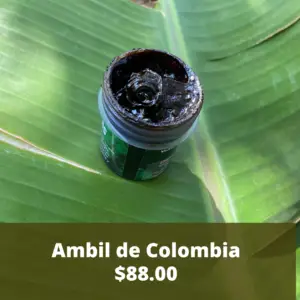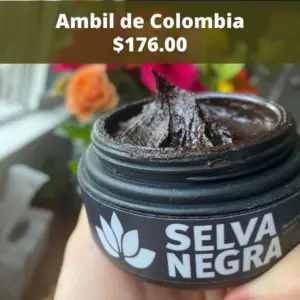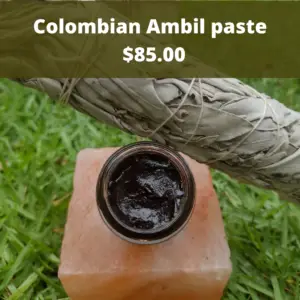
Looking to buy ambil medicine? Jump down to read more.
Affiliate Disclosure: Just a heads-up: Some of the links on this site are affiliate links. This means if you click on the link and make a purchase, we may earn a small commission at no extra cost to you. It helps keep the lights on around here, so thanks a bunch if you decide to buy through our links! Rest assured, we only recommend products and services we genuinely love and think you will too.
Table of Contents
What is ambil tobacco paste?
Ambil (in the Witoto/Huitoto language, yera) is a paste or syrup derived from tobacco and is often accompanied with mambe medicine.
It is a plant medicine prepared and used by indigenous groups from the northwest Amazon, including the Huitoto that inhabit the north of Peru and south-eastern Colombia.
In Venezuela and north Colombia, a similar paste exists called chimó, or chimú.
How is ambil made?
Ambil is made by boiling down tobacco tea (Nicotiana rustica) into a paste (sometimes also described as a syrup or jelly).
Alkaline salts are frequently added to ambil, as well as yucca, or manioc, starch in order to make it thicker.
Ambil containers are usually small, only 50-70 grams each and may vary in potency, depending on the initial concentration of tobacco tea.
How is ambil used?
Ambil, which carries a male energy, is often also used prior to an ayahuasca ceremony. Like rapé snuff and liquid tobacco, it relaxes the body and clears the mind, opens your third eye, helps you focus, and can facilitate integration of the ayahuasca or other plant medicine. However, if you take too much, it can also cause nausea, purging and anxiety.
Everybody reacts differently to stimulants, so if you are sensitive to tobacco in any form, try only small amounts of ambil at first.
Practically speaking, ambil is used by dipping a stick or small bone into the paste, transferring it onto a finger and rubbing the gums quickly absorbed into our blood. Once applied to the gums, the ambil becomes diluted by our saliva.
Some people use their finger to dip into the ambil, but this is less hygienic, especially if the ambil is being shared. Often, ambil users will carry a small bottle of ambil around their neck.

Ambil side effects?
Ambil, like chewing tobacco and cigarettes, contains nicotine, which is poisonous. To some people that are more sensitive to the substance, it might cause convulsions, diarrhea, hiccups, nausea. Tobacco tea can even be deadly to some individuals so if you decide to consume tobacco-based substances, ambil, cigarettes (rolled, organic), liquid tobacco through the nose are much safer than tobacco tea, which is sometimes offered as a cleanse/detox before ceremonies. Intentional or not, if you are consuming a lot of ambil or another tobacco-substance, it can have repercussions on your health. Everything in moderation and also listen to what your body is telling you.
Where can you buy ambil paste?
In the US, you can buy ambil paste from the following providers:
Ambil and Mambe
Mambe represents the sweet word; the word of life. Ambil represents balance in thought.
In Colombia, ambil and mambe are used together by communities to mambear; to gather in community where Elders share stories and wisdom with the younger generations and to discuss important topics and decisions or to sing together. If you’ve ever heard of a Círculo de Palabra, or circle of word, mambe and ambil are often used during these.
The order of consumption is usually: ambil (causing mouth to salivate), then mambe powder (absorbing saliva and placed in cheek pocket) and finally coca leaves (dried, chewed and added to mambe ball).
Ambil and mambe are taken in rounds, sometimes throughout the night, until dawn. The combination of plants keeps participants awake and as the night goes one, so do the stories, songs and jokes.
Traditionally, ambil is called, “the companion of thought” and should alway be taken with mambe. Mambe loosens the tongue, giving individuals the power of the word through stories, eloquence and honesty. Ambil, opens the ears and thought to really listen to what is being said. In this way, mambe and ambil enable a flow of communication during a sharing circle.
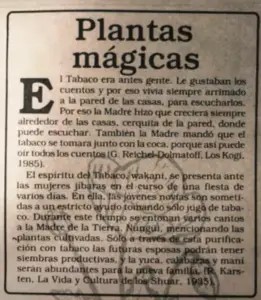
Tobacco plants often grow outside homes near the wall and are said to enjoy (l)eavesdropping on the lives of those living in the house. They lean against the walls to listen. Similarly, ambil, which is derived from the tobacco leaf, opens the ears to listen.
Ambil is usually represented by the male energy/figure and was generally consumed by the men of a community. Mambe, made of coca, is a female energy. Mambe and ambil, together, balance female and male energy.
Effects
Ambil has a strong flavor and character. Some people describe the flavor as bitter and salty.
When ambil is applied to the gums, the mouth begins to salivate quite profusely, which is why it is often taken with mambe medicine, which comes in the form of a fine powder. The saliva produced by the ambil is absorbed by the powder and easier to place in the cheek.
After consuming ambil, your body may get warmer and your heartbeat may increase. When taken little by little, as it is traditionally consumed, this effect is subtle and leads to overall calmness and relaxation.
However, if taken in larger amounts or if you are more sensitive to the effect of stimulants, ambil may cause anxiety and in even larger amounts, purging, either through vomiting or the bowels.
Benefits of ambil
Ambil represents balance in thought.
Some benefits of ambil include:
- Cleans the digestive systems, often through purging when taking in large quantities
- Cleanses the spirit
- Cleanses the blood
- Natural anti-parasitic
- Enhances concentration, clarity and receptivity of the mind
- Calms, relaxes the mind and body
Traditional preparation
Ambil is prepared in the following way:
- Mature tobacco leaves are harvested
- Leaves are washed well and boiled in water for several hours
- The remaining liquid is well strained, leaving tobacco juice or concentrated tea
- This liquid is boiled again and when it is thicker, vegetable salt and manioc powder are added to change the consistency and to add body and elasticity.
- This mix is cooked until resulting in a thick, syrup-like consistency.
The vegetable salt (sal de monte) used in ambil is made by filtering water through the ash of various plants, mainly palms.
First barks, shoots, and flowers of different plants that contain vegetable salt are collected. These plants are burned until only ash remains. The ash is collected in a cone made of bark and lined with banana leaves. Water is slowly filtered through using a fine filter or sieve. The water that passes through the ash is then simmered until salt remains at the bottom of the pot.
